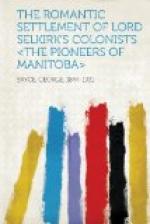The remains are those of a people whom we call ‘The
Mound Builders,’ who ages ago lived here.
Their mounds stood on high places on the river bank
and were used for observation. The enemy approaching
could from these mounds easily be seen. They
are also found in good agricultural districts, showing
that the race were agriculturists, and where the fishing
is good on the river or lake these mounds occur.
The Mound Builders are the first people of whom we
have traces here about. The Indians say that
these Mound Builders are not their ancestors, but are
the ‘Very Ancient Men.’ It is thought
that the last of them passed away some four hundred
years ago, just before the coming of the white man.
At that time a fierce whirlwind of conquest passed
over North America, which was seen in the destruction
of the Hurons, who lived in Ontario and Quebec.
Some of their implements found were copper, probably
brought from Lake Superior, but stone axes, hammers,
and chisels, were commonly used by them. A horn
spear, with barbs, and a fine shell sinker, shows
that they lived on fish. Strings of beads and
fine pearl ornaments are readily found. But the
most notable thing about these people is that they
were far ahead of the Indians, in that they made pottery,
with brightly designed patterns, which showed some
taste. Very likely these Mound Builders were
peaceful people, who, driven out of Mexico many centuries
ago, came up the Mississippi, and from its branches
passing into Red River, settled all along its banks.
We know but little of this vanished race. They
have left only a few features of their work behind
them. Their name and fame are lost forever.
“And is this all? an
earthen pot,
A broken spear, a copper
pin
Earth’s grandest
prizes counted in—
A burial mound?—the
common lot.”
THE GAY FRENCHMAN.
Then the conversation turned upon the early Frenchmen,
who came to the West during the days of French Canada,
before Wolfe took Quebec. “Oh! I have
no doubt they would make a great ado,” said the
old patriarch, “when they came here. The
French, you know, are so fond of pageants. But
beyond a few rumors among the old Indians far up the
Assiniboine River of their remembrance of the crosses
and of the priests, or black robes, as they call them,
I have never heard anything; these early explorers
themselves left few traces. When they retired
from the country, after Canada was taken by Wolfe,
the Indians burnt their forts and tried to destroy
every vestige of them. You know the Indian is
a cunning diplomatist. He very soon sees which
is the stronger side and takes it. When the King
is dead he is ready to shout, Long live the new King.
I have heard that down on the point, on the south
side of the Forks of the two rivers, the Frenchmen
built a fort, but there wasn’t a stick or a
stone of it left when the Selkirk Colonists came in
1812. But perhaps you know that part of the story
better than I do,” ventured the old patriarch.
That is the Story of the French Explorers.




